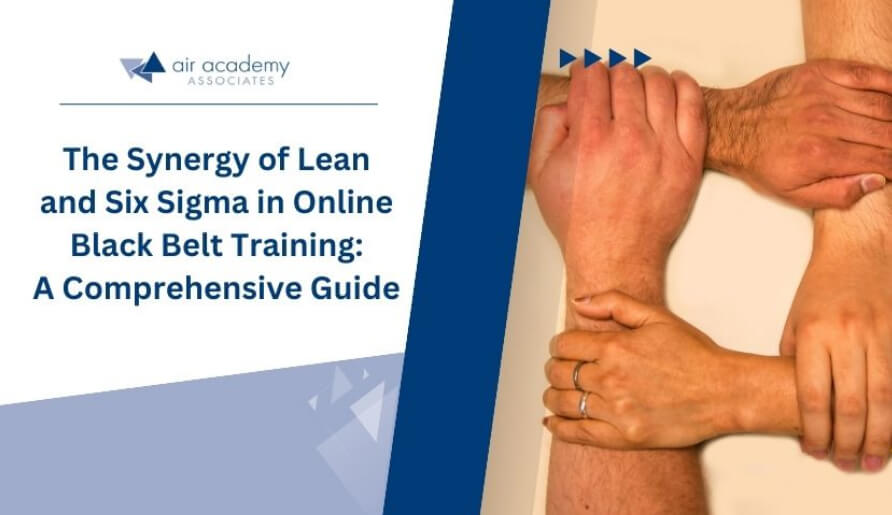
In the fast-paced business world, organizations constantly seek ways to improve efficiency, reduce costs, and enhance customer satisfaction. Two methodologies that have stood the test of time in achieving these goals are Lean and Six Sigma. While each has unique strengths and tools, the real magic happens when these two are integrated, especially at the Black Belt level of training.
This comprehensive guide explores the synergy between Lean and Six Sigma in online Black Belt training. We will explore their strengths, the key synergies when combined, how online Black Belt courses cover these methodologies, and how professionals can leverage this integrated approach for transformative gains in their organizations.
The Origin of Lean and Six Sigma
Before diving into their synergies, it’s crucial to understand the origins of Lean and Six Sigma. Lean originated from the Toyota Production System, focusing on eliminating waste and optimizing flow to deliver maximum value to the customer. On the other hand, Six Sigma was developed by Motorola and later popularized by General Electric, aiming to eliminate defects and reduce variability in processes through statistical analysis.
Complementary Strengths of Lean and Six Sigma

Image Source: Freepik
Lean Strengths
- Eliminates Non-Value Activities: Lean removes activities that don’t add value to the end product or service.
- Optimizes Flow: Lean aims to create a smooth, uninterrupted flow of materials, information, and work in progress.
- Frees Capacity: Lean frees up resources by eliminating waste, allowing for more productive use.
- Customer-Focused: Lean always keeps the customer’s needs at the forefront.
Six Sigma Strengths
- Reduces Defects and Variability: Six Sigma aims to make processes more predictable and reliable.
- Optimizes Process Capability: Through data-driven analysis, Six Sigma enhances the capability of processes.
- Data-Driven Statistical Rigor: Six Sigma uses statistical tools to analyze data and make informed decisions.
- Analytical Approach: Six Sigma employs a structured, analytical approach to problem-solving.
Key Synergies Between Lean and Six Sigma

Image Source: Pexels
Shared Purpose of Improving Processes
Both Lean and Six Sigma aim to improve processes, albeit through different approaches. Lean focuses on speed and flow, while Six Sigma emphasizes quality and reliability. When combined, they offer a holistic approach to process improvement.
Complementary Toolsets
Lean offers tools like Kanban, 5S, and Value Stream Mapping, which are excellent for visualizing workflow and identifying waste. Six Sigma brings in tools like Control Charts, Fishbone Diagrams, and Statistical Process Control, which are essential for data analysis and quality control.
Aligned Cultural Values
Both methodologies advocate for a culture of continuous improvement, transparency, and customer-centricity. This cultural alignment makes integrating Lean and Six Sigma easier within an organization.
Common Focus on Capability and Variation
While Six Sigma aims to improve process capability, Lean focuses on reducing variation in demand and supply. These objectives are closely aligned and complement each other well.
Continuous Improvement Mindsets
Both Lean and Six Sigma encourage a mindset of continuous improvement. Whether through Lean’s Kaizen events or Six Sigma’s DMAIC cycle, the focus is always on improving daily.
Integrated Lean Six Sigma Training in Black Belt Curriculums
Online Black Belt training programs offer a comprehensive curriculum covering Lean and Six Sigma methodologies. These courses include:
- Lean Concepts: Value Stream Mapping, Pull Systems, Kanban, 5S, and Poka-Yoke.
- Six Sigma Tools: Statistical Process Control, Capability Analysis, and Design of Experiments.
- Integrated Frameworks: DMAIC (Define, Measure, Analyze, Improve, Control) and DMADV (Define, Measure, Analyze, Design, Verify) are taught in Lean Six Sigma.
- Real-World Case Studies: These provide insights into how Lean Six Sigma has been successfully deployed in various industries like manufacturing, healthcare, and banking.
Applying Integrated Lean Six Sigma as a Black Belt

Image Source: Pexels
Once you’ve completed your online Black Belt training, you’re not just a certified professional but a change agent equipped with a powerful toolkit to drive organizational transformation. The real challenge, however, lies in the application of this knowledge. Let’s delve deeper into how you can apply the integrated Lean Six Sigma approach as a Black Belt.
Use Lean and Six Sigma Together in DMAIC Projects: An In-Depth Exploration
The integration of Lean and Six Sigma is most vividly seen in applying the DMAIC (Define, Measure, Analyze, Improve, Control) framework. This Six Sigma methodology can be supercharged with Lean principles to create a robust, holistic approach to process improvement. Let’s break down each phase of DMAIC to see how Lean and Six Sigma can be harmoniously integrated.
Define Phase: Aligning Problems with Organizational Goals
The Define phase focuses on clearly articulating the problem statement and ensuring it aligns with the organization’s strategic objectives. Here, Lean principles can add significant value:
- Customer-Centric Problem Definition: Lean’s emphasis on customer value can help define the problem from a customer’s perspective. This ensures that the project focuses on issues that are truly important to the customer, aligning with organizational goals.
- Hoshin Kanri: This Lean tool can be used for policy deployment and ensures that the problem statement is aligned with the company’s strategic goals, making the project more impactful.
Measure Phase: Quantifying the Current State
- The Measure phase involves gathering data to establish a baseline for current performance. Both Lean and Six Sigma offer tools for this:
- Statistical Tools: Six Sigma provides various statistical tools like histograms, Pareto charts, and descriptive statistics to quantify the current state.
- Value Stream Mapping: This Lean tool can be invaluable in visualizing the entire process flow, identifying waste, and establishing metrics that can be improved.
Analyze Phase: Identifying Root Causes
The Analyze phase is where the root causes of the problem are identified. Both methodologies offer unique perspectives:
- Root Cause Analysis (5 Whys): Lean’s simple yet effective tool can quickly identify the root cause of waste and inefficiencies in a process.
- Data Analytics: Six Sigma’s data-driven approach can be used to perform regression analysis, hypothesis testing, and other advanced statistical methods to pinpoint variations and defects.
Improve Phase: Implementing Solutions
The Improve phase is the heart of the DMAIC cycle, where actual changes are made to the process. This is where Lean shines:
- Kaizen: This Lean principle of continuous improvement can be applied through quick, incremental changes that yield immediate benefits.
- 5S: This Lean tool can be used to organize the workplace, making identifying and eliminating waste easier.
- Kanban: This Lean tool helps visualize work, limit work-in-progress, and maximize flow.
- Design of Experiments (DOE): Six Sigma’s DOE can be used to systematically test different solutions and optimize process variables, ensuring that the most effective solution is implemented.
Control Phase: Sustaining the Gains
The Control phase ensures that the improvements are sustained over time. Both Lean and Six Sigma offer tools for this:
Control Charts: Six Sigma’s control charts can monitor process performance over time, quickly identifying any deviations that need to be corrected.
Statistical Process Control (SPC): This Six Sigma tool helps maintain the gains by monitoring the process through statistical methods.
Standard Work: This Lean concept involves documenting the new best practices and making them the new standard, ensuring that the gains are institutionalized and sustained.
By integrating Lean and Six Sigma tools and principles in each phase of the DMAIC framework, Black Belts can ensure a more comprehensive, effective approach to process improvement. This not only maximizes the impact of each project but also ensures that the improvements are sustainable, delivering long-term value to the organization.
Leverage Lean’s Speed and Agility with Six Sigma’s Analytical Rigor
Lean is known for its speed and agility, focusing on quick wins and incremental improvements. On the other hand, Six Sigma is more analytical and data-driven, aiming for long-term gains. When you combine the two:
- Quick Wins + Long-Term Strategy: Use Lean for quick wins to gain momentum and show immediate results. This can be particularly useful to secure buy-in from stakeholders. Then, use Six Sigma’s analytical tools to solidify these gains and make them long-term.
- Pilot Testing: Use Lean to test changes on a small scale quickly. If successful, use Six Sigma’s statistical tools to validate the results before a full-scale implementation.
Involve Frontline Workers in Ground-Level Insights
One of the most overlooked aspects of process improvement is the involvement of frontline workers. These people are closest to the work and often have the best insights into where waste occurs and how processes can be improved.
- Gemba Walks: Use this Lean tool to go to the place where the work is done, observe the process, and talk to the employees. This will give you valuable insights you can’t get from data alone.
- Employee Training: Train employees in basic Lean and Six Sigma concepts so they can identify opportunities for improvement and contribute to problem-solving.
Benchmark and Align for Strategic Focus

Image Source: Pexels
It’s crucial to align your Lean Six Sigma projects with the organization’s strategic goals. This ensures that your efforts contribute to the bigger picture.
- Internal Benchmarking: Identify best practices within your organization and strive to implement them.
- External Benchmarking: Look at industry leaders and world-class organizations to see how they use Lean Six Sigma. Use this information to set ambitious yet achievable targets.
- Balanced Scorecard: Use this tool to align Lean Six Sigma projects with organizational objectives in finance, customer satisfaction, internal processes, and learning & growth.
By mastering the art of applying Lean and Six Sigma in an integrated manner, Black Belts can drive significant improvements in speed, quality, and cost-efficiency. This makes you an invaluable asset to your organization and places you at the forefront of operational excellence.
Conclusion
Integrating Lean and Six Sigma methodologies offers a potent blend of speed, quality, and efficiency. Online Black Belt training programs provide a comprehensive curriculum that equips professionals with the tools and knowledge to implement this integrated approach effectively. Organizations can achieve transformative gains by understanding and leveraging the synergies between Lean and Six Sigma, delivering exceptional value to customers and stakeholders alike.
With certified Black Belts adept at synergizing Lean’s speed and flexibility with Six Sigma’s analytical rigor, the path to organizational excellence becomes achievable and sustainable.
Experience the ultimate fusion of Lean and Six Sigma in our online Black Belt training program, designed to equip you with the tools to optimize performance and deliver exceptional results. Enroll at Air Academy Associates and become a certified Lean Six Sigma Black Belt, gaining the knowledge and credentials to stand out in today’s competitive job market.


